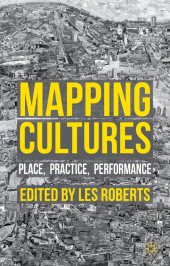 Neuerscheinungen 2012Stand: 2020-01-07 |
Schnellsuche
ISBN/Stichwort/Autor
|
Herderstraße 10
10625 Berlin
Tel.: 030 315 714 16
Fax 030 315 714 14
info@buchspektrum.de |

Les Roberts
Mapping Cultures
Place, Practice, Performance
Herausgegeben von Roberts, L.
2012. 2012. xiv, 309 S. 216 mm
Verlag/Jahr: SPRINGER PALGRAVE MACMILLAN; PALGRAVE MACMILLAN UK 2012
ISBN: 1-13-753395-1 (1137533951)
Neue ISBN: 978-1-13-753395-1 (9781137533951)
Preis und Lieferzeit: Bitte klicken
An interdisciplinary collection exploring the practices and cultures of mapping in the arts, humanities and social sciences. It features contributions from scholars in critical cartography, social anthropology, film and cultural studies, literary studies, art and visual culture, marketing, museum studies, architecture, and popular music studies.
Acknowledgements Mapping Cultures - a Spatial Anthropology; L.Roberts PART I: PLACE/TEXT/TOPOGRAPHY Critical Literary Cartography: Text, Maps and a Coleridge Notebook; D.Cooper Mapping Rohmer: Cinematic Cartography in Post-war Paris; R.Misek Cinematic Cartography: Projecting Place Through Film; L.Roberts Walking, Witnessing, Mapping: An Interview with Iain Sinclair; D.Cooper & L.Roberts Maps, Memories and Manchester: the Cartographic Imagination of the Hidden Networks of the Hydraulic City; M.Dodge & C.Perkins PART II: PERFORMANCE/MEMORY/LOCATION Urban Musicscapes: Mapping Music-making in Liverpool; S.Cohen Mapping the Soundscapes of Popular Music Heritage; P.Long & J.Collins Walking Through Time: Use of Locative Media to Explore Historical Maps; C.Speed Salford 7/ District Six. The Use of Participatory Mapping and Material Artefacts in Cultural Memory Projects; L.Cassidy PART III: PRACTICE/APPARATUS/CARTOGRAPHICS ´Spatial Stories´: Maps and the Marketing of the Urban Experience; G.Warnaby Mapping My Way: Map-making and Analysis in Participant Observation; H.Andrews Mental Maps and Spatial Perceptions: The Fragmentation of Israel-Palestine; E.Ben Ze´ev Peripatetic Box and Personal Mapping: From Studio to Classroom to City; S.Moro The Anthropology of Cartography; D.Wood Bibliography Index
"This collection gives a widely spread voice to the widening acknowledgement of what maps mean and do; how and where they occur. Comprising a series of related but distinctive, lively, well worked and critically engaging chapters, the book will find readers across a range of disciplines and subjects." - David Crouch, University of Derby, UK
"Mapping Cultures offers a collection of innovative studies and theoretical essays, each confronting the diffusion of cartographic method and rhetoric throughout humanities and social science research over the past two decades. . . . [the book] is brimming with insight into the emergent mapping practices and vocabularies by which we might better resist authoritarian, anti-democratic practices, which themselves do work through mapping. And it helps clear a path by which researchers in the humanities and social sciences alike might better understand and express that ´´it is not so much what people do with maps as it is what maps do with people´´ (Wood, p. 300). For this alone, the book is an important bridge between the relatively recent innovations of critical cartography, in particular, and a host of other fields just as recently innovated by the methods and metaphors of cartography in general." - Cartographica 48 (2), 2013.
"The book closes with a call for a more explicit critical reorientation towards mapping, and map use a project of the anthropology of cartography (D. Wood). This call seems to be still valid and one can admit that Mapping Cultures is a significant step towards achieving the goal. Readers from different disciplines will find valuable contributions both theoretical and empirical in the collection. For a tourism researcher or student, the book is thought-provoking for several reasons, not only because of the enhancing awareness of cartography in relation to areas such as cinema, music, travel..." - Tourism, Culture and Communication 12, 2013.


